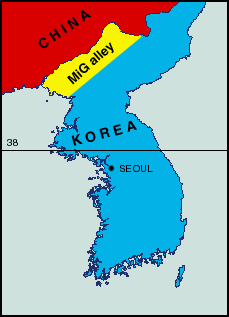|
Pilots of 77 Squadron started out
in the Korean War flying P-51 Mustang aircraft. Originally designed as a
fighter during the Second World War, the piston-engine Mustang had lost
its technical edge by the time of the Korean War, and was more suited to
ground-support roles.
When Soviet-built, MiG-15 jet
fighters appeared in Korean skies after China entered the war, they soon
demonstrated their superior performance. While American squadrons had
jet fighters of their own - F-80 Shooting Stars, and later Sabres - only
the Sabres could match the MiGs for performance and versatility.
| Also, the name of
Thunderbolt was adopted for the jet, but the British officials
were 'shocked' to find that the pesky Americans had beat them to
the draw with the P-47! After careful observation to make
sure the same mistake was not repeated, the jet was named the
Meteor. |
In April 1951, 77 Squadron
replaced its Mustangs with the British-built twin-jet Meteor Mark 8. The
RAAF pilots were trained on the Meteors by four experienced British RAF
pilots, at the Iwakuni base in Japan.
Although the Meteor had also been
developed during the Second World War, it was thought to be more capable
of surviving encounters with the Soviet MiG-15 jet. In Korea, air-to-air
combat entered the jet age, but when in August 1951 the jet adversaries
met, the Meteors did not fare well. The MiGs speed (1084 km/hour, 122
km/hour faster than Meteors), rate of climb, and performance at high
altitudes made MiGs a far superior aircraft. In subsequent months, the
role of the Meteor as a fighter was reconsidered, and it was withdrawn
from "MiG Alley" for use as a ground-attack aircraft in areas
where MiGs were rarely encountered.
 |
"MiG Alley"
was the nickname
given the area between Chongchon Valley and Yalu River, on the
Manchuria/Korea frontier.
The area was a focus to intercept
Chinese MiG fighters, who were based at a Chinese airfield over
the border in Antung.
While UN airpower remained generally
superior over the rest of Korea, MiG Alley remained the most
dangerous area to RAAF pilots.
It was also frustrating because UN
pilots were forbidden to cross the Yalu River, so MiGs could fight
them, and then return to base over the border without any fear of
pursuit.
|
Type: Single Seat Jet Fighter
Power Plants: Two 1,700lbs/thrust Rolls Royce
Welland turbojets
Armament: Four 20-mm cannon in nose
Performance: Maximum Speed 458mph
Weights: Empty 8,140lbs
MiG Alley map and some
wording from http://www.awm.gov.au/korea/weapons/mustangs/mustangs.htm |